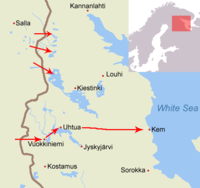Viena expedition
| Viena expedition | |||||||||
|---|---|---|---|---|---|---|---|---|---|
| Part of Heimosodat | |||||||||
 Initial Finnish Advance | |||||||||
| |||||||||
| Belligerents | |||||||||
| |||||||||
| Commanders and leaders | |||||||||
|
|
| ||||||||
| Strength | |||||||||
| Finland 1,500 |
Red Guards and Karelians 1,550 Royal Marines 130 | ||||||||
| Casualties and losses | |||||||||
| 122 dead | Red Guards and Karelians 100-150 | ||||||||
The Viena expedition (Finnish: Vienan retkikunta, Swedish: Vienaexpeditionen) was a military expedition in March 1918 by Finnish volunteer forces to annex White Karelia (Vienan Karjala) from Soviet Russia. It was one of the many "kinship wars" (Heimosodat) fought near the newly independent Finland during the Russian Civil War. Russian East Karelia was never part of the Swedish Empire or the Grand Duchy of Finland. and it was at the time mostly inhabited by Karelians. However, many advocates of a Greater Finland considered these Karelians a "kindred" Finnish nation and supported the annexation of Russian East Karelia to Finland.
Northern Group
The expedition was made up of two groups. One group was
Southern Group
Initial Operations

The other group was led by
When the Finnish troops arrived in White Sea Karelia, they noticed that the population was divided. Part of the population wanted to secede from Russia and form an independent
British Intervention
The situation became more complicated with the landing in
The situation of the Viena expedition began to deteriorate. The Karelian regiment stationed in Kem attacked the Finnish troops at
Outcome
In the end, the expedition failed due British efforts to prevent then German-aligned Finland from gaining access to the Murmansk railroad.
Two years later, after the last of the
See also
- Aunus expedition
- Finnish Civil War
- Metsäsissit
- North Russia Campaign
- Pork mutiny
- Murmansk Legion
Notes
- ^ Group under Kurt Martti Wallenius consisted of conscripted soldiers initially ordered to clear Northern Finland from remaining Red Finns. Troops mutinied and were at very low morale after crossing the border.
- Finnish Jäger troops or part of the White Guard. However before taking part to the operation as volunteers they were required to resign from the military. Forces were however sponsored and to some extent supported by government.
- ^ The Republic of Uhtua was more of a Finnish puppet state than a unrecognized state.
References
- ISBN 978-91-7903-442-9.
- ISBN 1-85285-477-4. Retrieved 2010-08-15.
